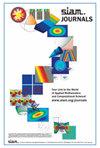彩色图像正则化的弹性模型
IF 2.3
3区 数学
Q3 COMPUTER SCIENCE, ARTIFICIAL INTELLIGENCE
引用次数: 0
摘要
选择合适的正则化测度在图像处理领域中起着重要的作用。一种经典的方法将彩色图像视为嵌入在五维空间色彩空间中的二维表面。在这种情况下,自然正则化项作为图像表面积出现。选择色坐标占主导地位而不是空间坐标,我们可以认为图像空间坐标可以作为图像表面流形在三维色彩空间中的参数化。最小化图像流形的面积会导致图像表面在三维色彩空间中的贝尔特拉米流或平均曲率流,而最小化图像表面的弹性会产生额外的有趣的正则化。最近,我们提出了一种颜色弹性模型,该模型可以最小化图像流形的表面积和弹性。本文对彩色图像正则化模型进行了改进,提出了两种新的彩色图像正则化模型。基于灰度图像的颜色弹性模型、欧拉弹性模型和总变分模型之间的关系,提出了改进的度量方法。与我们之前的彩色弹性模型相比,新模型是欧拉弹性模型对彩色图像的直接扩展。所提出的模型是非线性的,很难最小化。为了克服这一困难,提出了两种算子分割方法。具体地说,非线性是通过引入新的向量和矩阵值变量来解耦的。然后,将最小化问题转化为初始值问题,并通过算子分裂进行时间离散。每个子问题在分裂后,要么具有封闭解,要么能够有效地求解。综合实验证明了所提模型的有效性和优越性。与常见的替代方案相比,将图像表面的弹性作为正则化项的好处得到了经验验证。本文章由计算机程序翻译,如有差异,请以英文原文为准。
Elastica Models for Color Image Regularization
The choice of a proper regularization measure plays an important role in the field of image processing. One classical approach treats color images as two- dimensional surfaces embedded in a five-dimensional spatial-chromatic space. In this case, a natural regularization term arises as the image surface area. Choosing the chromatic coordinates as dominating over the spatial ones, we can think of the image spatial coordinates could as a parameterization of the image surface manifold in a three-dimensional color space. Minimizing the area of the image manifold leads to the Beltrami flow or mean curvature flow of the image surface in the three-dimensional color space, while minimizing the elastica of the image surface yields an additional interesting regularization. Recently, we proposed a color elastica model, which minimizes both the surface area and the elastica of the image manifold. In this paper, we propose to modify the color elastica and introduce two new models for color image regularization. The revised measures are motivated by the relations between the color elastica model, Euler’s elastica model, and the total variation model for gray level images. Compared to our previous color elastica model, the new models are direct extensions of Euler’s elastica model to color images. The proposed models are nonlinear and challenging to minimize. To overcome this difficulty, two operator-splitting methods are suggested. Specifically, nonlinearities are decoupled by the introduction of new vector- and matrix-valued variables. Then, the minimization problems are converted to initial value problems which are time-discretized by operator splitting. Each subproblem, after splitting, either has a closed-form solution or can be solved efficiently. The effectiveness and advantages of the proposed models are demonstrated by comprehensive experiments. The benefits of incorporating the elastica of the image surface as regularization terms compared to common alternatives are empirically validated.
求助全文
通过发布文献求助,成功后即可免费获取论文全文。
去求助
来源期刊

SIAM Journal on Imaging Sciences
COMPUTER SCIENCE, ARTIFICIAL INTELLIGENCE-COMPUTER SCIENCE, SOFTWARE ENGINEERING
CiteScore
3.80
自引率
4.80%
发文量
58
审稿时长
>12 weeks
期刊介绍:
SIAM Journal on Imaging Sciences (SIIMS) covers all areas of imaging sciences, broadly interpreted. It includes image formation, image processing, image analysis, image interpretation and understanding, imaging-related machine learning, and inverse problems in imaging; leading to applications to diverse areas in science, medicine, engineering, and other fields. The journal’s scope is meant to be broad enough to include areas now organized under the terms image processing, image analysis, computer graphics, computer vision, visual machine learning, and visualization. Formal approaches, at the level of mathematics and/or computations, as well as state-of-the-art practical results, are expected from manuscripts published in SIIMS. SIIMS is mathematically and computationally based, and offers a unique forum to highlight the commonality of methodology, models, and algorithms among diverse application areas of imaging sciences. SIIMS provides a broad authoritative source for fundamental results in imaging sciences, with a unique combination of mathematics and applications.
SIIMS covers a broad range of areas, including but not limited to image formation, image processing, image analysis, computer graphics, computer vision, visualization, image understanding, pattern analysis, machine intelligence, remote sensing, geoscience, signal processing, medical and biomedical imaging, and seismic imaging. The fundamental mathematical theories addressing imaging problems covered by SIIMS include, but are not limited to, harmonic analysis, partial differential equations, differential geometry, numerical analysis, information theory, learning, optimization, statistics, and probability. Research papers that innovate both in the fundamentals and in the applications are especially welcome. SIIMS focuses on conceptually new ideas, methods, and fundamentals as applied to all aspects of imaging sciences.
 求助内容:
求助内容: 应助结果提醒方式:
应助结果提醒方式:


